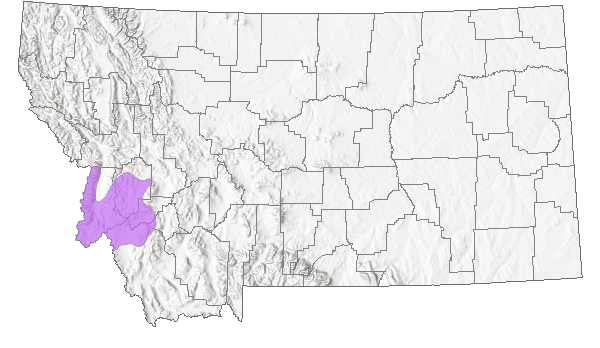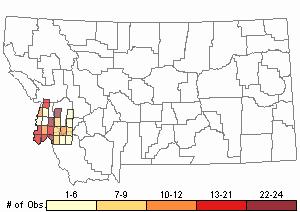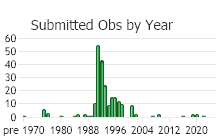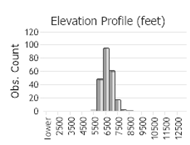View in other NatureServe Network Field Guides
NatureServe
Montana
Utah
Wyoming
Idaho
Wisconsin
British Columbia
South Carolina
Yukon
California
New York
Candystick - Allotropa virgata
State Rank Reason (see State Rank above)
Limited distribution and small population sizes make the species potentially vulnerable to impacts to its habitat, primary lodgepole pine stands. Trend and monitoring data for the species are lacking. However, populations are presumed to be relatively stable at the present time.
General Description
Candystick has pink and white-striped stems, 1-4 dm high and 5-10 mm thick. Stems are clothed in white to pinkish, alternate, lance-shaped leaves that are largest near mid-stem. Flowers are borne in tight clusters in the axils of the upper leaves (bracts). Each flower has 5 separate white to pinkish sepals, ca. 5 mm long, and 10 purple stamens. Petals are lacking. The 5-lobed ovary matures to form a many-seeded capsule.
Phenology
Flowering in July and August.
Diagnostic Characteristics
The pink and white stems lacking green leaves are distinctive.
Species Range
Montana Range
Range Descriptions

 Native
Native
Range Comments
Southern Sierra Nevada Mountains and the coastal ranges of California, north to British Columbia from the eastern slope of the Cascade Range to near the coast; disjunct in Idaho and southwestern Montana. Disjunct.
Observations in Montana Natural Heritage Program Database
Number of Observations: 233
(Click on the following maps and charts to see full sized version)
Map Help and Descriptions
Relative Density

Recency



 (Observations spanning multiple months or years are excluded from time charts)
(Observations spanning multiple months or years are excluded from time charts)
Habitat
Deep humus of mature, usually lodgepole pine forests in the montane zone.
Ecology
Allotropa virgata lacks chlorophyll and it obtains nutrients from other vascular plants through a mycorrhizal (fungal) association. Matsutake mushroom mycelium are reported as the mycorrhizal associate.
Management
Suitable management practices that maintains lodgepole pine stands and associated litter/duff layers in which the mycorrhizal associate are located are neccassary.
Stewardship Responsibility
Threats or Limiting Factors
STATE THREAT SCORE REASON
Reported threats to Montana’s populations of Candystick are currently assigned as unknown (MTNHP Threat Assessment 2021). Widespread loss of lodgepole stands would have detrimental outcomes for Candystick populations. Information is needed about negative impacts to Candystick populations expected within a 10-year timeframe in order to evaluate the threat of shifting habitat using NatureServe methods.
References
- Literature Cited AboveLegend:
 View Online Publication
View Online Publication MTNHP Threat Assessment. 2021. State Threat Score Assignment and Assessment of Reported Threats from 2006 to 2021 for State-listed Vascular Plants. Botany Program, Montana Natural Heritage Program, Helena, Montana.
MTNHP Threat Assessment. 2021. State Threat Score Assignment and Assessment of Reported Threats from 2006 to 2021 for State-listed Vascular Plants. Botany Program, Montana Natural Heritage Program, Helena, Montana.
- Additional ReferencesLegend:
 View Online Publication
View Online Publication
Do you know of a citation we're missing? Castellano, M. A., and J. M. Trappe. 1985. Mycorrhizal associations of five species of Monotropoideae in Oregon. Mycologia 77(3): 499-502.
Castellano, M. A., and J. M. Trappe. 1985. Mycorrhizal associations of five species of Monotropoideae in Oregon. Mycologia 77(3): 499-502. Furman, T. E. and J. M. Trappe. 1971. Phylogeny and ecology of mycotrophic achlorophyllous angiosperms. Quarterly Review of Biology 46:219-225.
Furman, T. E. and J. M. Trappe. 1971. Phylogeny and ecology of mycotrophic achlorophyllous angiosperms. Quarterly Review of Biology 46:219-225. Lesica, P., M.T. Lavin, and P.F. Stickney. 2012. Manual of Montana Vascular Plants. Fort Worth, TX: BRIT Press. viii + 771 p.
Lesica, P., M.T. Lavin, and P.F. Stickney. 2012. Manual of Montana Vascular Plants. Fort Worth, TX: BRIT Press. viii + 771 p. Lesica, P., M.T. Lavin, and P.F. Stickney. 2022. Manual of Montana Vascular Plants, Second Edition. Fort Worth, TX: BRIT Press. viii + 779 p.
Lesica, P., M.T. Lavin, and P.F. Stickney. 2022. Manual of Montana Vascular Plants, Second Edition. Fort Worth, TX: BRIT Press. viii + 779 p. Lichthardt, J.J. 1992. Population monitoring of Allotropa virgata (candystick) on the Nez Perce National Forest: third-year results. Unpublished report. Idaho Department of Fish and Game. Boise, Idaho. 21 pp.
Lichthardt, J.J. 1992. Population monitoring of Allotropa virgata (candystick) on the Nez Perce National Forest: third-year results. Unpublished report. Idaho Department of Fish and Game. Boise, Idaho. 21 pp. Lichthardt, J.J. 1995. Conservation strategy for Allotropa virgata (candystick), Northern and Intermountain Regions, U.S. Forest Service. Unpublished report to U.S. Forest Service. Idaho Conservation Data Center, Boise, Idaho. 24 pp. plus appendics.
Lichthardt, J.J. 1995. Conservation strategy for Allotropa virgata (candystick), Northern and Intermountain Regions, U.S. Forest Service. Unpublished report to U.S. Forest Service. Idaho Conservation Data Center, Boise, Idaho. 24 pp. plus appendics. Lorain, C. C. 1988. Floristic history and distribution of coastal disjunct plants of the northern Rocky Mountains. M.S. thesis. College of Forestry, Wildlife, and Range Sciences, University of Idaho, Moscow. 221 pp.
Lorain, C. C. 1988. Floristic history and distribution of coastal disjunct plants of the northern Rocky Mountains. M.S. thesis. College of Forestry, Wildlife, and Range Sciences, University of Idaho, Moscow. 221 pp. Poole, J.M. 1992. Results of field surveys for Allotropa virgata in the Beaverhead and Deerlodge National Forests. Unpublished report. Montana Natural Heritage Program, Helena, MT. 11 pp. plus appendix.
Poole, J.M. 1992. Results of field surveys for Allotropa virgata in the Beaverhead and Deerlodge National Forests. Unpublished report. Montana Natural Heritage Program, Helena, MT. 11 pp. plus appendix. Roe, L.S. 1992. Status review of Allotropa virgata, U.S.D.A. Forest Service, Region 1, Bitterroot and Deerlodge National Forests, Montana. Unpublished report, Montana Natural Heritage Program 71pp.
Roe, L.S. 1992. Status review of Allotropa virgata, U.S.D.A. Forest Service, Region 1, Bitterroot and Deerlodge National Forests, Montana. Unpublished report, Montana Natural Heritage Program 71pp. Steele, R. and P.F. Stickney. 1974. Allotropa virgata (Ericaceae), first records for Idaho and Montana. Madrono 22(5):277.
Steele, R. and P.F. Stickney. 1974. Allotropa virgata (Ericaceae), first records for Idaho and Montana. Madrono 22(5):277. Takahashi, H. 1987. Pollen morphology and its taxonomic significance of the Monotropoideae (Ericaceae).
Takahashi, H. 1987. Pollen morphology and its taxonomic significance of the Monotropoideae (Ericaceae). Wallace, G. D. 1977. Studies of the Monotropoideae (Ericaceae) Floral nectares: anatomy and function in pollination ecology. American Journal of Botany 64:199-206.
Wallace, G. D. 1977. Studies of the Monotropoideae (Ericaceae) Floral nectares: anatomy and function in pollination ecology. American Journal of Botany 64:199-206.
- Web Search Engines for Articles on "Candystick"





